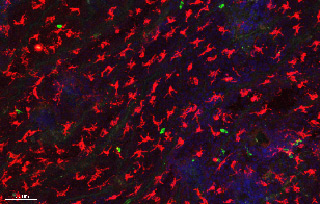Intraepithelial T cells in anti-viral immunity
-
Project Leader

Professor Francis (Frank) Carbone+61 3 8344 9923
Project Details
Intraepithelial γδ T cell in the skin also known as Dendritic Epithelial T Cells (DTEC) are unique from the typical T cell population in their anatomical location, dendritic morphology, slightly activated state and fast innate like responses to local trauma (Figure 1). Seeded into the skin epithelium only during fetal ontogeny, production of these T cells ceases soon after birth. Following flank Herpes Simplex Virus (HSV) infection, HSV specific memory CD8 killer T cells can also lodge the same location and form a tissue resident subset that can protect against subsequent infections. We are interested in whether DETC can provide immunity against cutaneous HSV infection in the acute phase and also whether they affect the formation and function of the resident memory CD8 killer T cells. We are also interested in the epithelialization of resident memory CD8 killer T cells and similarities between resident memory CD8 killer T cells and DETC in this regard. These studies will enhance our knowledge of the complex interplay between innate and adaptive as well as unconventional and conventional T cells in anti-viral immunity.

Figure 1: Dendritic Epidermal T cells in mouse epidermis. γδ T Cells (red), CD8 T Cells (green) and nuclei (blue).
Research Group
Faculty Research Themes
School Research Themes
Molecular Mechanisms of Disease, Cellular Imaging & Structural Biology
Key Contact
For further information about this research, please contact the research group leader.
Department / Centre
MDHS Research library
Explore by researcher, school, project or topic.